총 44 개의 게시물이 있습니다.
-
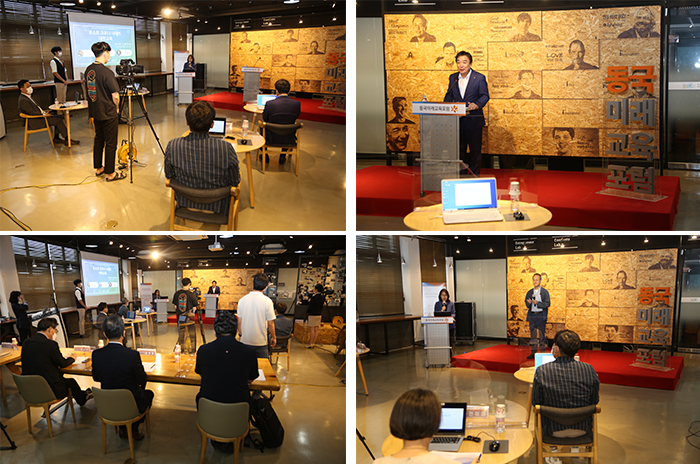
Dongguk University Launches the “Dongguk Future Education Forum”
Dongguk University Launches the “Dongguk Future Education Forum”Under the Theme of “University Education in the Post-COVID-19 Era”Dongguk University (President Yoon Sung-yee) has launched the Dongguk Future Education Forum to lead changes in university education in the post-COVID-19 era.The inauguration ceremony and the First Dongguk Future Education Forum were held both online and offline at i.SPACE, on the third floor of Wonheung Hall, Dongguk University, on September 11 at 3pm.To comply with social distancing guidelines, only a small number of select people (including the keynote speaker, topic presenters, and debaters) attended the forum in person."I believe that the Dongguk Future Education Forum will play a pivotal role in preparing for an unpredictable and rapidly changing future," said Yoon Sung-yee, President of Dongguk University, who delivered congratulatory remarks at the forum. “I hope that all professors and representatives of our university will share a wide range of knowledge and information, and develop ways to accurately predict the future through this forum,” he said. The keynote speech was given by Professor Choi Jae-cheon from Ewha Womans University, and covered “The Post-COVID-19 Era: Changes in Society and Education.” “In situations such as the one we are facing during the coronavirus pandemic, where our existence itself is threatened, we need an ecological transformation,” he said. “Although it is important to reflect on how we teach at the university, we really need to think about what we should teach.” He emphasized that “one of the most important topics that needs to be taught and studied is how we can live with nature.”The first topic presented during the forum, “Response to the COVID-19 Era: Dongguk University's EdTech Spread Strategy” was presented by Kim Hyeon-seok, Director of the Teaching and Learning Development Center at Dongguk University. "In the era of the fourth industrial revolution, a preemptive response to future environmental changes is required due to technological advancements and a decrease in the school-age population," said Director Kim. “Dongguk University plans to upgrade the full-cycle student competency support system, Dream PATH+, to disseminate EdTech and establish a data-based decision-making system to upgrade the consumer-centered teaching and learning-support system.”Professor Bae Sang-hoon from Sungkyunkwan University presented the second topic of the forum, “The Crisis Faced and Opportunities Developed in University Education Due to COVID-19.” Professor Bae shared a university education strategy for the post-corona era, focusing on the case of Sungkyunkwan University. “In terms of higher education, the post-COVID-19 era will be an era in which each student is valued and must attend smart universities, and an era in which society will need to develop cooperation and co-prosperity, rather than competition,” he said. “The steps we must take now include changing the paradigm focus on ‘student success,’ giving up our vested rights, trusting and encouraging one another, narrowing our focus, and doing our share in our own institutions.”Lee Kang-woo, Director of the Convergence Education Center at Dongguk University; Kim Jong-pil, Director of Naeil Shinmoon; Lee Je-jun, President of the student body at Dongguk University; and Kim Jeong-do, President of the student body at Dongguk University Graduate School joined the presenters for a discussion, following the presentation of topics. The forum was broadcast live on YouTube, and members of the public as well as the university were invited to watch it in real time. Later, the forum video was posted on Dongguk University’s official YouTube channel (https://www.youtube.com/user/MYDGUTV), where it can be viewed at any time.“We created this forum to set a direction and define tasks related to educational innovation in the post-COVID-19 era, as well as to share and disseminate these,” said the forum organizer, Jeon Mi-kyeong, Dean of Educational Innovation at Dongguk University. “Dongguk University will continue to seek ways to innovate and improve the quality of education (the original mission of the ‘ivory tower’) through the Future Education Forum.”
2020.09.18. 조회 2159 -

DU Wins Their First Championship Cup in Nine Years
DU Wins Their First Championship Cup in Nine Years Defeats Soongsil University 2-1 at the National University Soccer Confederation Fall Game The Dongguk University’s (DU) soccer team won their first championship cup in the 56th National University Soccer Confederation Fall Game in nine years. On August 28, 2020, DU defeated Soongsil University 2-1 in the final match that took place at Taebaek Stadium in Taebaek, Gangwon Province.In the quarterfinals, DU beat Honam University 2-0, and initially tied 2-2 with Cyber Hankuk University (Foreign Studies) in the semifinals, but then took the lead in a 5-3 penalty shootout to move up to the finals. In the finals, Soongsil was in the lead by 0-1 at the end of the first half, but 17 minutes into the second half, Hwang Myung-hyun (freshman) scored a goal for DU to even the score. Later, 30 minutes into the second half, Lee Kyu-bin (sophomore) scored the winning goal to clinch a dramatic victory for DU.DU was the champion of the National University Soccer Confederation Fall Game for two consecutive years in 2010 and 2011, the winner of Jungbu Region 2 in the University League in 2013, and had also won the 11th Freshman–Sophomore University Soccer Autumn Championship in 2014. Under the leadership of Manager Ahn Hyo-yeon, who was appointed to take over the team of his alma mater in 2017, the DU team finally succeeded in winning the championship cup at the National University Soccer Confederation Fall Games after a 9-year drought.Yoon Sung-yee, President of Dongguk University, was at Taebaek Stadium to cheer on the school’s team during the final match. He said "it was a game where DU’s soccer team showed its brave and pure spirit without holding back,” and added, “(I am) very happy and grateful that all the players’ hard work under the leadership of Manager Ahn Hyo-yeon has paid off, and hope that they will continue to uphold DU’s soccer reputation.”
2020.09.14. 조회 1430 -
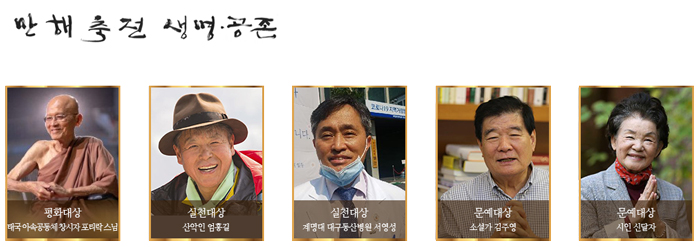
Five Winners Selected for the 24th Manhae Prize
Five Winners Selected for the 24th Manhae PrizeMonk Phra Bodhirak, the founder of Thailand’s Santi Asoke, and others selected: Awards ceremony to be held on Wednesday, August 12The Manhae Festival Promotion Committee (chaired by Kwak Chae-gi, Executive Vice President for Academic Affairs at Dongguk University) announced the five winners of the 24th Manhae Prize on Wednesday, July 15. This year’s Peace Prize goes to monk Phra Bodhirak, the founder of Thailand’s Santi Asoke. The Practice Prize is awarded to mountaineer Um Hong-gil and the Keimyung University Daegu Dongsan Hospital (Director Suh Young-sung). The Literature Prize is jointly awarded to writer Kim Joo-young and poet Shin Dal-ja. The highlight of the 2020 Manhae Festival—the Manhae Awards Ceremony—will take place next month, on Wednesday, August 12, at the Hanuelnaerin Center in Inje-gun, Gangwon-do. The Manhae Festival, which celebrates the spirit of Reverend Manhae (Han Yong-woon, 1879–1944), is co-hosted by Dongguk University, Gangwon-do, Inje-gun, Chosun Ilbo, and the Society for the Promotion and Practice of Manhae’s Thoughts. Various programs will be conducted, such as the Yusim Literature Prize ceremony, academic seminars, culture and art events, contests, and local college events.The Manhae Prizes are awarded to individuals who have made a significant impact worldwide in one of the following three areas: Peace, Practice, and Literature. Previous winners include former South African President Nelson Mandela, the Dalai Lama, former Chairman of the Hyundai Group Chung Ju-yung, former Korean President Kim Dae-jung, Catholic priest Ham Sei-ung, former Sorokdo nurse Marianne Stoeger, novelist Jo Jung-Rae, and Nobel Prize in Literature laureate Mo Yan.Monk Bodhirak, this year’s Manhae Peace Prize winner, is a figure who realized the life of non-violence and peace as found in scriptures. Once a composer and television programmer with wealth and fame in Thailand, he was ordained a monk with the resonating idea: “I, like the Lord Buddha, did not succumb to wealth, fame, and comfort.” He criticized the ineffectiveness of the orthodox ecclesiastical order and formed Santi Asoke, a community that practices simplicity and self-sacrifice; the followers live Buddha’s life and the community currently comprises five different villages, nine schools, six vegetarian restaurants, four organic fertilizer factories, three rice mills, two herbal medicine factories, one hospital, and a 160-hectare farm. In the community, monks eat once a day and reside in huts (kuti) to renounce their worldly possessions. Other followers, consisting of couples and children, while enjoying freer and more active lives than the monks, also find happiness in their communal livelihoods in the absence of greed.The Manhae Practice Prize winner, Um Hong-gil, is widely known for scaling the summits of all 14 Himalayan peaks (eight-thousanders) higher than 8,000 meters in 2000. With deep affection toward adolescents and those with disabilities, he established the Um Hong Gil Human Foundation in 2008, which has since been devoted to education work in the Nepalese Himalayas and remote villages. In addition, the Um Hong Gil Foundation Hospital opened and has been in operation at the entrance of the Himalayas Everest in Kumbu Namche (3,440 meters) since May 2017. He has also conducted activities for supporting Korean mountaineers’ surviving families since 2011, providing KRW 373 million in total as of June 2020. The co-winner of the Practice Prize, Keimyung University Daegu Dongsan Medical Center, was the last bastion of quarantine situated at the frontline in the battle against COVID-19. On February 21, three days after the first COVID-19 case was reported on February 18, the Daegu Dongsan Medical Center rapidly evacuated all hospital rooms to focus exclusively on the treatment of COVID-19 patients; the hospital managed to host a total of 1,022 COVID-19 patients. This was 13% of the infected patients in Daegu and 9% of the total COVID-19 patients in the country—a number that no other hospital in the country has managed to surpass. The Manhae Literature Prize winner Kim Joo-young is a writer who avidly explores the lives of ordinary folks that are not heroes and casts them as main characters of historical fiction. He made his literary debut with A Period of Dormancy in 1971, which won the New Writer’s Award in Literature Monthly; he then rose to fame through his 1979 saga, The Innkeeper. Kim produced multi-volume historical novels such as Righteous Band of Brigands, Yajeong, and The Wanderers, and continues to publish works at the age of 80. Through his publications that eloquently depict the lives and customs of laypeople from the past, Kim has demonstrated outstanding achievements that will remain in the history of Korean literature and its international exchange. Another co-winner of the Literature Prize, poet Shin Dal-ja, has published a total of 15 poetry collections. With Bongheonmunja as her debut into the literary circle, her works include The Water of Home, The Light of the Father, Mother, That Crooked Writing, Passionate Love, Paper, and The Northern Village, which was written during her two years of living in Bukchon Hanok Village and aimed to promote its beauty and history. She explores love from meeting and departing, life from birth to death, and these phenomena and nature as creatures that create and extinguish, based on her quest for human existence from an ontological perspective. Along with the title as the “poet of reconciliation and healing,” Shin is regarded as an author who boldly pioneered and represented the field of female poetry in Korean literature.
2020.07.28. 조회 1670 -
Twenty Dongguk University Alumni Elected into the 21st National ...
Twenty Dongguk University Alumni Elected into the 21st National AssemblySeven undergraduate alumni and thirteen graduate school alumni win their seatsTwenty Dongguk University alumni were elected as members of the 21st National Assembly in the country’s legislative elections which were held on April 15, 2020. A grand total of 56 alumni and faculty members were registered as candidates for this election. Notably, alumnus Hong Young-pyo won his fourth consecutive term for the constituency Bupyeong B, Incheon, and alumnus Chun Jae-soo was reelected for Buk–Gangseo A, Busan. Seven of the elected alumni are graduates of Dongguk University’s undergraduate schools while the other thirteen completed are products of the graduate schools. The party affiliations of the elected individuals are as follows: nine for the Democratic Party, eight for the United Future Party, two for the Future Korea Party, and one for the Platform Party. Among them, seventeen were elected from district constituencies and two were elected from proportional representations.
2020.06.30. 조회 1367 -
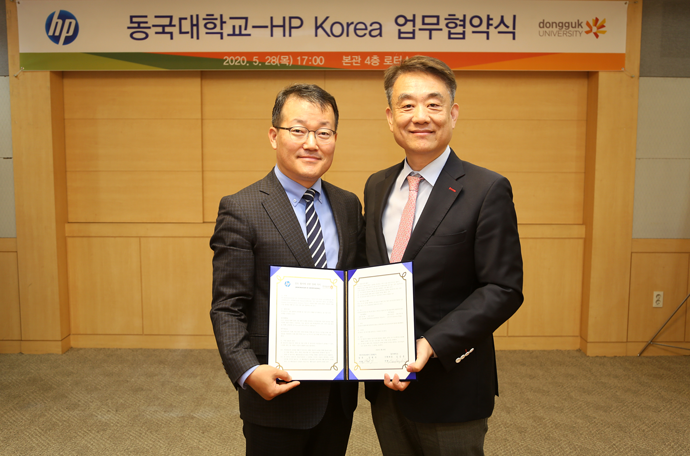
HP Korea & Dongguk University, Working “Hand-in-Hand” to Foster ...
HP Korea & Dongguk University, Working “Hand-in-Hand” to Foster Printing Business Managers▲ HP Korea and Dongguk University entered a business agreement to develop the printing market at Lotus Hall, Dongguk University on May 28. Professor Kim Seung-yong, Director of Planning & Budget, Dongguk University (left), and Kim Byung-soo, Managing Director, Indigo, HP Korea (right)On May 28, HP Korea signed a business agreement with Dongguk University for training printing business managers and the advancement of the digital printing market.Dongguk University will offer a major program associated with Graphic Communication Science at the School of Business Administration from the fall semester starting in September 2020.HP Korea will support digital printing education and practical training in the associated program that will be offered at Dongguk University. HP Korea and Dongguk University will work hand-in-hand to educate students on the latest digital printing technologies and solutions to foster professionals in the domestic printing industry and further develop the regional industry.HP Korea will actively support digital printing education and practical training in line with Dongguk University’s move to train printing business executives and managers.Dongguk University’s curriculum will include a variety of information, such as digital printing product development using HP Indigo (a digital printing solution of HP), the latest trends in digital printing technology, and business opportunities through digital printing. This is to increase the understanding of the printing industry and lead the growth of the industry.HP will select outstanding students and provide them with internship opportunities at HP as well as overseas training prospects. In addition, practical training opportunities will be offered in various digital printing areas in association with partner companies.Based on their mutual cooperation, HP Korea and Dongguk University are also set to develop university printing platform startups.It is expected that the printing orders in the university will be handled by printing through HP Indigo, thereby supporting the popular use of high-quality printing materials in the university, satisfying printing demands on campus at a reasonable cost, and providing business experience opportunities to future printing business managers. Kim Byung-soo, Managing Director of the Indigo Division, HP Korea said, “This agreement is a result of the efforts made to contribute to the progress of the domestic printing industry, fostering of printing business professionals, and growth of the regional industry based on the know-how of HP, which has led the global digital printing industry. Based on the cooperation agreement with Dongguk University, we will continuously seek the role of HP can play in strengthening the competitiveness of the South Korean digital printing industry.”
2020.06.10. 조회 1479 -

The Journey of Successfully Landing a Job at SoftBank, Japan
The Journey of Successfully Landing a Job at SoftBank, JapanNever lose confidence and keep working hard toward your dreams! ▲ A photograph with colleagues after completing the internship at SoftBankMeet a Dongkuk alumnus with great aspirations of venturing into the vast world. In an interview, Kim Da-hyun (Department of Industrial and Systems Engineering, class of 2015), who was offered a job with a large overseas company, tells us how she decided to find a job overseas and landed an opportunity to work as an engineer at SoftBank, a leading Japanese company with a global presence. Q Could you give us a brief introduction of yourself?My name is Kim Da-hyun, and I majored in Industrial and Systems Engineering and Convergence Software. I love traveling and watching movies on Netflix. I am going to work at SoftBank as an engineer. Currently, I’m enjoying my free time, which is never guaranteed in the future.Q What motivated you to seek employment outside Korea?As I have always enjoyed traveling abroad, I thought about doing some kind of work outside Korea. I believe that the exchange student program directly motivated me. As I was taking classes in Japan, my desire to live in Japan grew. So I decided to find a job overseas because I think it is best to get a job where I can utilize my major as opposed to gaining temporary work experience through a working holiday.Q Why did you decide to study in Japan as an exchange student?When I was in high school, I had a chance to visit Japan for two weeks through a homestay program sponsored by the City of Seoul. I kept in touch with a Japanese friend I had met at that time. Later, we even visited each other in our home countries. When I became a college student, I found out about the exchange student program and thought, “Why not go to Japan?” That was the main reason. Q Did you experience any difficulties because of the language?It was early in the spring semester of my freshman year when I made the decision to join the exchange student program. During that summer, I began to prepare for it by attending a private language school to study Japanese. Being an exchange student naturally improved my Japanese skills because I had no option but to speak in Japanese as there were hardly any Korean students. Besides, I was able to handle difficulties rather quickly due to my easy-going nature, which enabled me to make friends in the process of expanding my horizons as I experienced a variety of things. While preparing for my job search, I studied business Japanese and additionally studied Japanese on the phone. During my senior year in college, I went to Japan to work as an intern. There, I began to watch at least 30 minutes of Japanese news each morning, and practiced writing resumes, which gradually helped improve my Japanese. Q What did you do in preparation for landing a job overseas?I attended recruitment fairs at the career center on campus and job fairs in Japan. Even though hiring managers from Nissan and Amazon were present at the recruitment fairs, I did not apply for any jobs because I had just begun to prepare for my future career. However, I remember an opportunity to submit a job application immediately after the presentation. In addition, there is an initial settlement support service provided by the government once the employment is confirmed. I hope you will take advantage of these services. Q Please tell us about SoftBank.Comparable to telecom providers SKT, KT, LGU+ in Korea, Japan has SoftBank, Docomo, and AU as the three major mobile phone companies. Focusing on mobile communication business, SoftBank is conducting various business projects including Big Data and AI. A simple payment service called “PayPay” is among the most popular services in Japan, and is also well known in Korea because of the CEO, Son Jung-ui!Q What are your responsibilities at the company?Specific job responsibilities have not yet been assigned. Unlike Korea, Japanese companies hire people without specific jobs in mind. However, SoftBank recruits employees for two different fields: general office jobs (sales, planning, etc.) and engineering jobs (system, network, etc.). I passed the test for an engineering job, so I will learn about my department and job responsibilities at the end of the new employee training. I will be working as either an AI engineer, Big Data engineer, or a systems engineer based on my top three listed preferences. Q Please tell us a little about the recruitment process in Japan.The recruitment process in Japan is quite different from that in Korea. In general, companies in Japan conduct an annual open recruitment. They usually prepare for the open recruitment in March and start accepting applications in April. After screening all applicants, the recruitment process concludes by September, and the new employee initiation ceremony is held at the beginning of October. Then, new employees commence their jobs in April the following year. However, I was recruited through the early recruitment program for interns, instead of the regular recruitment process. After completing my internship in September 2018, I submitted my application in October. Then, I was notified of acceptance in December. That is how I got to work with the new recruits for 2020.Q What is the secret of your success? I don’t have any secrets, but I believe that my endeavoring personality matches the type of employee sought by SoftBank. Receiving a favorable evaluation on the internship also gave me a huge advantage. What SoftBank valued most were likely my communication skills and work ethics, and my lack of fear to take risks to tackle challenges. Sometimes I hear people say that it is easy to land a job in the midst of recruitment war. To some degree, it seems that the threshold for employment is lower in Japan than in Korea. During the job interview, I got the impression that they had a higher regard for the applicant’s potential, personality, and capability than specifications. Still, when I think of the new employees hired with me, I cannot say that specifications are not important. As for expats, it may be even more challenging because foreigners must be fluent in Japanese.Q What type of talents do you think SoftBank is looking for?In my view, SoftBank seeks individuals who always strive for betterment and adjust to new changes quickly. These five tenets are important to SoftBank: Speed, Excellence, Ambition, Commitment, and Retrospection. I think that the interviewing committee took those things into consideration. Interviewers always asked me “What inspired you to look for employment in Japan?"Q What would you like to achieve in your career?I hope to live a full life, with no regrets when I look back on my life five years later. To do so, I intend to accomplish small achievements one after another, focusing on what I can at the moment. Won’t I accomplish something if I keep working hard? In other words, my goal is to make an achievement that is recognized by the company.Q What is your ultimate goal?At present, it is not easy for me to give a clear answer. I have always set goals and strived toward achieving them. I still have many aspirations. On the one hand, I hope to work in the U.S. branch or the Chinese branch after gaining some experience and work skills. On the other hand, I hope to become an executive at the company and return to Korea with valuable experience. As I am just beginning my job as a new recruit, I will need some time to think about what I really want to do in the future. Q Can you share some advice with the Dongkuk alumni who want to work overseas?You may get lonely if you are independently preparing for a job interview with no support. I felt the same way. I believe you should never lose confidence, and keep striving toward the goal. You will eventually have a satisfying result if you keep working on your cover letter, personality test, aptitude test, and job interview. Even if you fail, continue to endeavor toward your goal without feeling discouraged. I root for all those who are preparing to land a job overseas!
2020.02.26. 조회 1194 -
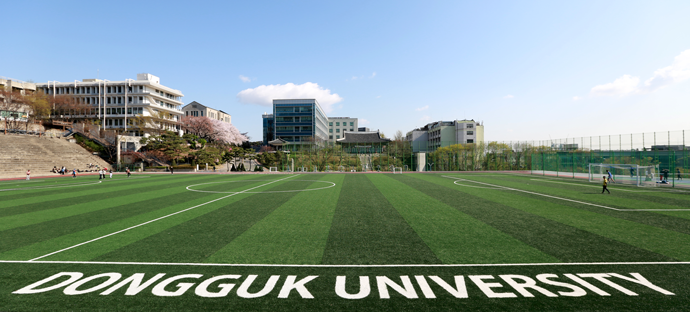
Dongguk University has been selected as the “Best University” in...
Dongguk University has been selected as the “Best University” in the Dong-A Daily Youth Dream University evaluation Selected for the third time consecutively for employment and start-up support According to the results of the 2019 Youth Dream University evaluation, which Dong-A Daily and Ministry of Employment and Labor, Korea Employment Information Service conduct with the research company, Macromill Embrain, on December 9, Dongguk University was selected as the best university for the third consecutive time.The Youth Dream University evaluation, which was introduced in 2013, is being held for the fifth time this year. It focuses on how actively a university supports employment of the students and start-ups and how effectively does it run the career guidance system. This year, the Youth Dream University was selected based on the information on 224 four-year universities from across the nation published in Higher Education in Korea. Dongguk University is growing into a startup campus that represents Korea both in name and reality by introducing an active business-friendly bachelor’s system, including the undergraduate major linked to start-up, leave of absence system for start-ups, establishment of general graduate school of technology and start-ups, and operation of start-up credit system for fostering a university start-up culture. For the first time in Korea, it has launched a leave of absence system for start-ups, which allows students who establish a start-up to take a leave of absence for up to two years (four semesters). As of 2019, it has been evaluated that more than ninety students are pursuing the dream of becoming entrepreneurs. The differentiated career support system offered by the university also stands out. Dongguk University's Big Career Service logically organizes the Top 30 companies that have hired the maximum number of graduates and shares employment information related to these companies. In addition, alumni can find information on employment. It also provides statistics on field trips, double majors, international exchanges, and job programs that business alumni seniors found useful for employment. An important point is that since 2012, it has offered a platform for students to compare their employment competency with seniors who have been employed by companies based on their graduate degree and supports the current students to develop the capabilities that they lack.
2020.01.13. 조회 1736 -

Professor Kwak Moon-kyu, appointed as the chairman of the Korean...
Professor Kwak Moon-kyu, appointed as the chairman of the Korean Society for Noise and Vibration Engineering The term is one year starting from January 2020 Professor Kwak Moon-kyu from the Department of Mechanical and Robot Energy Engineering at Dongguk University, Kwak Moon-kyu, is the eighteenth chairman of the Korean Society for Noise and Vibration Engineering. on the 1st.Korean Society for Noise and Vibration Engineering was established with the purpose of contributing to the development and dissemination of studies and technology on noise and vibration. It aims to contribute toward the promotion of science and technology to address the public's desire for a pleasant living environment. It celebrated its thirtieth anniversary this year.The society is a corporation affiliated to the Ministry of Environment established with the participation of various fields such as machinery, architecture, civil engineering, aviation, shipbuilding and marine, electricity, and electronics. It has more than 4,000 members including regular members, special members, and group members.Professor Kwak Moon-kyu said, “The emergence of the 4th industry means that technology related to the existing noise and vibration is being born in new form.” He also said, “Based on this, we will absorb experts in the field of noise and vibration derivatives and in the connected fields to develop the society into one that combines more diverse fields.”
2020.01.13. 조회 1395 -
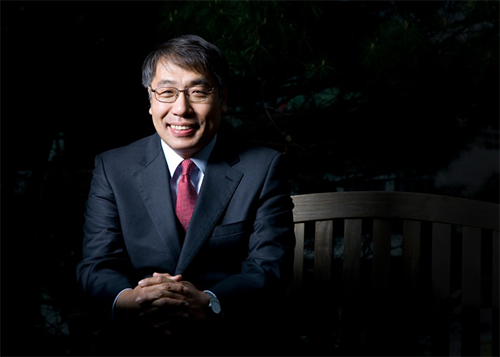
Professor Lim Gun-ill, elected president of the Korean Tissue En...
Professor Lim Gun-ill, elected president of the Korean Tissue Engineering and Regenerative Medicine SocietyThe term is one year starting from January 2021Professor Lim Gun-ill, the president of the Research Institute for Integrative Regenerative Biomedical Engineering of Dongguk University, has been elected as the next president (term from January 1, 2021 to December 31, 2021) at the meeting of the Board of Directors of the Korean Tissue Engineering and Regenerative Medicine Society held on December 26. Korean Tissue Engineering and Regenerative Medicine Society is a leading society in stem cell regenerative medicine in Korea. It has hosted the World Tissue Engineering and Regenerative Medicine Conference (TERMIS World Congress) in Seoul in 2009 and Asia-Pacific Tissue Engineering and Regenerative Medicine Conference (TERMIS AP Congress) in Daegu in 2014. Professor Lim Gun-ill has also been appointed as the president of the Asia-Pacific Tissue Engineering and Regenerative Medicine Conference, which will be held at the Jeju Convention Center in October 2022.
2020.01.13. 조회 1187 -
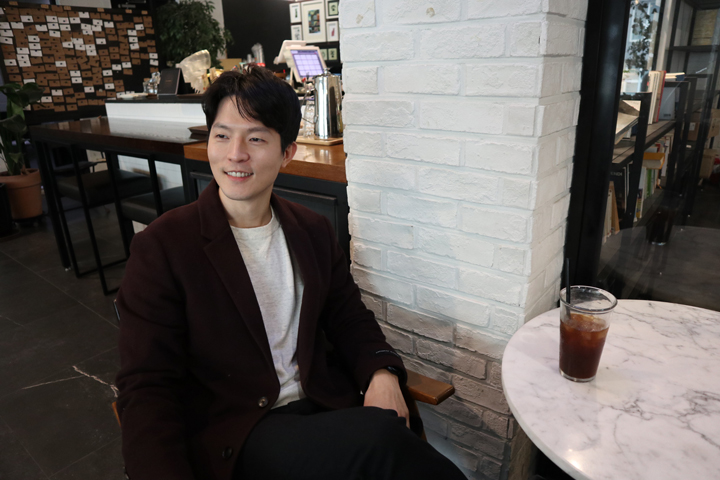
There will be a moment when everything is perfect
There will be a moment when everything is perfectInterview with Professor Kim Tae-gyeom of “Acting and Creative Thinking”“Things can go wrong, but it’s not the wrong way. I hope you to try anything. At least you would realize what you’ve done wrong. If you don’t lose your trust in yourself, everything will be perfect one day.” Professor Kim Tae-gyeom finished “Acting and Creative Thinking” this semester with this last word.Professor Kim, who is an actor at the same time, recently appeared in many works such as〈The Fiery Priest〉,〈Special Labor Inspector Jo Jang Poong〉, and〈Mr. Temporary〉. He graduated from the Division of Theatre, and now he is pursuing a Ph.D. in Dongguk.What class is “Acting and Creative Thinking”?You can look back on yourself by analyzing character. To be frank with you, I do want to give a chance to do what students want to do. Many students are having a hard time to prepare for their job these days. I think it is good to talk about yourself and listen to others. Give yourself a break in this class.How was the class this semester?Until last semester, I thought I had to give students correct direction as an adult and let them know what I learned. I realized that I was foolish. You are right. There were great acting performances (in the final exam) and I was very surprised. Some of them performed the play with the story they wanted to tell, and others created new content or reinterpreted existing content. All the fourteen teams were impressive.Does teaching students who don’t major in acting help your acting?I can remind original intention from acting non-majors. While I am an adult in acting, the students have childlike purity. They are the gemstones themselves. I see the purity I’ve forgotten. At some point, I often lose the rough gem which I had when I first start acting. I learn a lot from them. It is not easy, but I try not to forget the heart.Do you have any reason for entering graduate school?Making a quick debut was my goal when I was in college. After finishing the third grade, I took a leave of absence and worked hard at Daehak-ro for two years and then I made a debut in 2012. However, I missed my school life. I came back to school and worked hard from workshop. Luckily, I played the main character Stanley in a play titled “A Streetcar Named Desire.” I think I learned Dongguk(?) acting style a lot.Then I went to an agency and I only brewed coffee at the cafe in the agency for three months. I couldn’t even act so I just left and it disappeared. I felt discouraged and hopeless. At that time, the deceased Professor Ahn Min-soo was in graduate school. I felt lack of learning, so I chose to learn from the master.Is there synergy between working two jobs; acting and teaching acting.?I think it is easy to forget the eagerness and genuineness that I had when I started acting. An actor is, after all, a job. No matter how much you love your work, it is likely that you’ll be tired and lost first intention at some point. Watching the students’ acting, I could go back to my mind at the beginning. It is pleased to meet students who remind me of the purity of those days. I think students are teaching me.What kind of actor do you want to be?I want to be a blameless senior to my disciples or juniors. Also, I want to be an intellectual including Kim Sang-joong and Lee Soon-jae. They are my role models.Please give a word to Dongguk student whose dream is to be an actor.Please find another job quickly. I’m just joking. If you love acting, you can’t help it. However, please do not choose this work because you’re going through a hard time with your work. All the job may be harsh. I think there is no difference here. In particular, it is hard to do well as you endeavor, and difficult to be loved by the public as well. Moreover, it’s even difficult to keep that love. Don’t flee to this work. Start acting when you feel you have to.Hwang Hae-sudhfl00@dongguk.edu
2019.12.24. 조회 1187






